
Turning Strangers into Students™ (and Advocates) – A Study on Inbound Marketing and Recruitment in Higher Education (Part 1)
By Dr. Jean Norris, Norton|Norris, Inc., Managing Partner, and Linda Ganster, Managing Partner, The Grandview Group
Recently, a former school owner and advocate of career colleges stated,
“The timing on the recovery of the for-profit sector is in direct correlation to fixing the problem in admissions.”
Schools have long had a focus on the performance of the admissions office since this department is central to the initial student experience and is the driver of new revenue. That reality coupled with heightened government scrutiny and changing consumer behavior means that those working in student recruitment face unprecedented challenges.
This study aims to stimulate further exploration of these challenges by outlining the current situation facing career colleges, the impressive opportunities available to the sector, and a proposed 3-part solution to create a more effective, credible and transparent marketing and admissions process.
Current situation
Admission offices are being asked to adjust to a new “normal” of heightened compliance oversight. The demise of once profitable schools is hard to ignore when faced with evidence of lawsuits1, closures2, and poor public perception3 at every turn. Increasing tuition rates have also caused many to question whether a college degree is even worth the cost.4
The question is, how has an entire segment of higher education that has done so much good for so many people come to this place? In our view, a number of factors have contributed to this situation. There have been significant shifts in consumer buying preferences; the traditional marketing and admissions model is broken; and there are consistent gaps in the professional preparation of admissions representatives. We’ll examine each of these contributors individually.
Consumer buying behavior
As consumer behavior has changed, so has that of prospective students. New customer-centric norms have been established including the demand for 24/7 responsiveness; desire for easy access and customized information; increased reliance on customer opinions and reviews; and the ability to control the buying cycle process and speed.5 In fact, a 2012 study by Google followed 3,000 consumers on their paths to purchase and found 3,000 DIFFERENT paths.6
This points to an informed consumer that is in control of the buying process, and yet many schools attempt to reach their prospects primarily via telephone, often leaving voicemail messages that are likely to never be retrieved.7 These realities have negative implications for any school with one-size-fits-all messaging and admissions approaches.
Broken marketing and admissions model
The sales funnel of old actually was proposed by Elias St. Elmo Lewis in 1898 as a means of mapping a theoretical customer’s journey from initial product awareness through to purchase or action. In the world of higher education, the labels of “lead to set” and “set to show” all the way through to “lead to enrollment” have been long-standing benchmarks of comparison and planning. But, this all changed when Internet leads entered the funnel. At that point, schools could buy huge volumes of non-exclusive and lower quality leads (or inquiries) cheaply. Business practices did not adapt to the realities of the influx of cheap leads: resources were not added to handle this volume, nor did many realize that sales practices needed to shift in order to have any chance of converting shared leads that are being simultaneously recruited by many other schools. The cumulative result was that admission representatives were forced to use more aggressive selling techniques. The problem is that today’s consumer doesn’t respond to these hard-core tactics.
Career schools are far from alone in this new reality. Just take a look at major organizations like Google, Visa, Intuit and Twitter. In a study by Harvard Business Review (May, 2014), top marketing executives were asked about the relevance of the traditional sales funnel. All found it irrelevant given that the consumer is now in control.
It is definitely now a more circular process with consumers determining where they enter the buying cycle and how long they choose to stay or move through it.8
“In both B2B and B2C businesses, customers are doing their own research both online and with their colleagues and friends. Prospects are walking themselves through” the buying cycle, “then walking in the door ready to buy.”8 Organizations that force consumers (and in this case, students) into limited options to get information, risk losing market share. In other words, you will only get the people who choose to buy the way you sell.
Gaps in professional preparation
An analysis of current job postings for admissions representatives shows an emphasis on sales ability but only modest educational requirements, as minimal as a high school diploma.9 This is particularly troubling considering their role promotes the value of higher education. Additional opportunities for training and professional development are often limited, since other avenues are closed off to career college admission representatives. The most widely recognized professional association for college admissions counseling does not accept for-profit colleges as institutional members.10 These are indicators that raise the possibility that current admissions staff may be underprepared to succeed in the challenging environment in which they find themselves.
An additional concern is a change in the historical role of high school counselors. Previously, colleges could assume that high school counselors worked with students to explore educational and career options, creating more informed consumers. However, burgeoning caseloads have created unmanageable student-to-staff ratios, and admission representatives are not effectively trained in essential key competencies to fill the void. The result is that that “quality college counseling [is] a scarce commodity in public schools.”11 And now think about adults returning to school who may need this type of guidance more than ever. This puts the burden of adequately assisting prospective students about their opportunities squarely on the shoulders of college admission professionals.
Opportunities
There is a bright side for career colleges in this situation, and it comes from America’s intense, some would say dire, need for a more educated workforce.
There is a critical skills gap among our workforce, much of which has been attributed to unmet needs in higher education:
- 73 percent of U.S. companies foresee an increasing need for middle-skills jobs over the next few years, yet 56 percent are struggling to find qualified candidates. 12
- According to recent Bureau of Labor statistics, more than half a million new jobs are expected between 2010 and 2020 in each of four job areas – registered nurses, home health aides, personal care aides, and retail sales people. The six categories of occupations that typically need some amount of postsecondary education are expected to grow faster than the average for all occupations, while those occupations that require a high school diploma or less will grow more slowly than the average. 13
- Of first-time college students who enrolled in a community college in the fall of 2008, only 39.1 percent earned a credential from a two- or four-year institution within six years.14
- Since the eighties, the U.S. has fallen from its position as the world’s leader in producing a college-educated workforce. The U.S. now ranks 12th out of 36 developed countries in the number of college-educated citizens between the ages of 25 and 34. The graduation rates for both high school and college have also fallen off sharply. 15
Getting the right fit between a student’s goals, needs, and values and the institution is a critical factor in retention,16 and the cost of a poor fit is high: almost half of students who leave school in their first year, never return to post-secondary education.17 This belief is echoed in the words of James Kvaal, deputy director of the White House Domestic Policy Council. He states, “College counseling is a key leverage point because it touches on the academic, financial and informational barriers that students – especially low-income and first-generation students – face in going to college.” He goes on to state, “College counseling is one of the few tools we have that can address all three of those barriers at the same time.”18
In viewing the burden faced by high school counselors, a recent report stated, “it is no surprise that students and families would also look to admission officers for advice on linking education with career interests.”19 We believe admission representatives are ideally positioned to serve in this role and make positive changes on the success of individuals in school, in their career, and in their life.
Three-part proposed solution
These challenges and opportunities demand that career colleges step up with new solutions to remain relevant and even to lead the way. We are proposing one such solution that includes three equally important components: a new marketing/recruitment model, process automation, and improved professional development for admissions staff.
Image 1: A New Solution
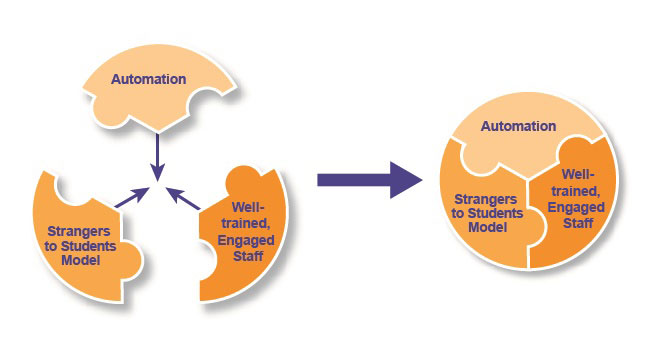
New model
Companies like Visa have moved to models focused first and foremost on building trust and relationships with an emphasis on branding. It is also understood that the consumer is in control of the research and buying process and prefers to pull information useful to them.20 This approach stands in stark contrast to many career college models that withhold information and require an admissions visit as an initial step.
An inbound marketing solution can be applied to address the issues facing schools and colleges today while more effectively and transparently servicing the needs of a prospective student. The model entitled, Turning Strangers into Students™, (Image 2) involves five phases in the student journey that can be strategically employed to nurture a relationship and offer meaningful experiences to convert inquiries to students and ultimately advocates of your school.
Image 2: Turning Strangers into Students™
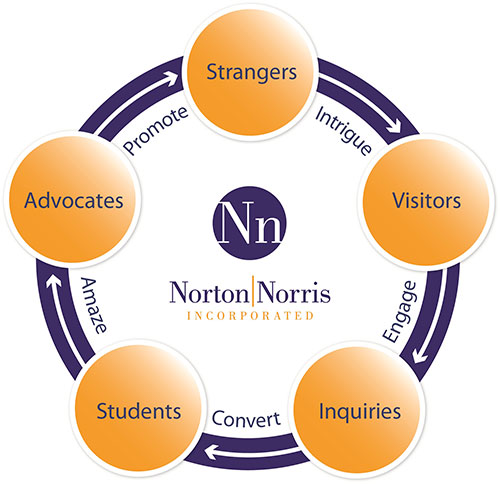
This model captures the entire student journey from pre-inquiry through satisfied graduate with opportunities to win or lose at any stage. Success is ultimately based on an organization’s strategies (and flexibility) to intrigue, engage, convert, amaze and ultimately have that student advocate as a key member of your marketing efforts.
Admissions process automation
Remember the days when a surgeon performed procedures manually? Or, when you navigated using only a paper map (that never folded back up the same way it came)? How about when a cashier had to manually ring up the price on every item and count your change back to you? In each of these instances, automation has made vast improvements to the reliability, effectiveness, and efficiency of the jobs undertaken. Now, imagine what the role of automation could be in admissions – improving customer service and ensuring compliance, while saving money at the same time. Do you think it is impossible? Well, consider this:
It has been estimated that 47 percent of total U.S. jobs could be automated and taken over by computers by 2033 and it’s not just blue-collar jobs. In a recent Fortune article, the author states, “researchers are beginning to see that artificial intelligence, robotics and new disruptive technology are challenging white-collar professionals that previously seemed invulnerable.”21
What’s causing this major shift? Basically, “technology has become more sophisticated” and the sheer speed of technological advancements and the availability of data, leads to machines that can now perform “higher level cognitive tasks.”20 A similar article in Business Insider claims, “The machines of the Industrial Revolution overcame limitations of human muscle, while the robots and artificial intelligence of today are overcoming the limitations of our individual minds.”22
Those statements could certainly be viewed as a threat to the jobs of admission representatives. After all, if a machine can do the job better, why do we need humans at all? Looking at the examples cited earlier, it is easy to make the connection between the initial automation of the retail sales experience and the self-checkout lanes that have replaced cashiers at major chain stores. This does not directly translate to the role of the admissions professional however. We believe the future admissions role is more similar to the surgeon’s role of automation in surgery. The surgeon has NOT been replaced. Instead, automation has improved the surgeon’s job by improving efficiency and reliability while reducing the risk of error.
Improved professional development for admission professionals
To service students to the highest degree, admission representatives remain a vital resource, but in new ways.
The student-consumer has been empowered through technology to seek out, research, and move through the buying cycle without the need for a campus visit or a conversation.
In addition, today’s students are hyper aware when they are being “sold” so former training methodologies must be aligned.
There is a renewed opportunity to transform this job into a sought after prestigious profession. This evolution will require new levels of training, validated best practices, and a network of continued support. Providing this advanced level of development will create a new generation of confident, empowered and engaged representatives.
The study
To determine the effectiveness of this 3-part solution, we launched a study on Aug. 10, 2015 to test the following hypotheses:
- H1: The “Strangers to Students” model is effective in improving student engagement
- H2: Automation of a prescribed coaching process is desirable for prospective students
- H3: Automation of a prescribed coaching process is desirable for admission professionals
- H4: Automation of a prescribed coaching process positively impacts return on investment (ROI)
- H5: Automation can improve accuracy of information provided to prospective students
- H6: Admission professionals desire enhanced training and development opportunities
Beta test participants (n=62) are currently employed and actively serving in the role of admission representatives from four randomly selected career colleges representing 22 campuses across the United States. All admission representatives have been trained on a prescribed admissions coaching process known as EnrollMatch®*. A point person (a licensed EnrollMatch® trainer for the school/college) was also identified to manage communication, additional training, and data collection. Access and training for the My Guidance Coach® (MGC) software was provided through this point person at each campus.
My Guidance Coach® (MGC)
MGC provides a proven guidance coaching service for prospective students to determine program and school fit. This legally endorsed software is available 24/7 from mobile, tablet and desktop devices to alleviate compliance risk while allowing for a customer-driven experience**. In addition, MGC provides the ultimate flexibility by working seamlessly with admission professionals to maximize resources and service.
The research plan
A survey of admissions experiences was created in two parts. The first part of the survey was administered prior to the beta test to collect baseline results on pre-existing practices, attitudes, experiences and opinions. Staff was then given access and training in the use of MGC. The second part of the survey will be administered following 30 days of use of MGC to test hypotheses and assess changes.
During the test period, schools have been asked to utilize the software in three ways. First, schools were asked to email a link to past inquiries that did not convert to an enrollment. The link took the prospective student to a custom sign up page and then into MGC. Next, select schools were provided with a banner or tile to place on their school’s website to engage “Strangers to Visitors” who may not be ready to inquire but want advanced services such as a hassle free coaching session. Prospective students have the option to covert from a “Visitor to Inquiry” and request to connect with a live admission representative by selecting the date, time and method they prefer.
In tandem, representatives were asked to utilize the MGC software and coaching process with all admission interviews (virtually or face-to-face).
Initial results
At this stage of the research, the pre-beta survey is complete. Fifty-seven respondents have submitted surveys representing a 92 percent return rate. Results show that outbound phone marketing is still a dominant marketing strategy, with 88 percent of respondents indicating that they feel phone calls are either somewhat or very effective in reaching students.
Interestingly, 88 percent also either agreed or strongly agreed that technology has changed the way that admissions representatives interact with students, yet 65 percent do not use either chat or Skype and 13 percent do not even use email as initial contact strategies.
Perhaps most indicative of the hold that outbound marketing retains is the fact that respondents report spending, on average, TWICE the amount of time on outbound calls (26 percent) as they do on inbound ones (13 percent).
In responding to a question about the biggest challenges they face, admission representatives provided answers that fell into consistent categories with significant overlap between them:
Student obstacles (18)
“The biggest challenges would have to be current obstacles examples: child care, transportation, financial.”
“Student obstacles and no true plan or way to overcome.”
Student commitment and motivation (13)
“My biggest challenge is students not showing up for Orientation to start school.”
“The flakiness of them not keeping appointments.”
“Determining their true level of commitment to not only starting the program but to finishing the program.”
Communication (7)
“Initial contact with the student continues to be the greatest challenge.”
“Sometimes the student is very quiet or doesn’t know how to answer the questions. Sometimes they feel like they’re in an interview and get shy/clam up. It can be hard to pull them out of their comfort zone at that point.”
What emerged from this initial phase of research is a picture of admissions representatives who feel that they are doing the correct things and doing them well. However, the obstacles they mentioned, as well as the environmental challenges we’ve discussed, tell a somewhat different story. This disconnect may indicate that representatives are not aware of the potential of new solutions to improve their experiences and effectiveness. The next phase of research will shed further light on that possibility.
Next steps
Join us in an upcoming issue to learn more about the beta test results and to answer the questions posed. We certainly are curious!
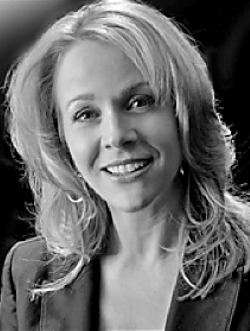
Dr. Jean Norris , is one of the leading advocates for the Admissions profession. In her 28-year career, she has served in the role of admission counselor, dean of admissions, faculty member, vice president of marketing, vice president of enrollment management, and vice president of organizational development at private colleges and universities across the U.S. Currently, Jean is a managing partner at Norton Norris, Inc., a Chicago-based marketing/consulting/training firm focused exclusively in the higher education sector.
Jean is the visionary behind the patent-pending software, My Guidance Coach® (MGC), which is an extension of the proven EnrollMatch® admissions training program. Thousands of admission professionals have already realized the impact of the EM system and the automation of key components was a natural next step to meet the needs of compliance and today’s student.
Dr. Norris earned a Doctor of Education Degree in Organizational Leadership, a MA in Communication and Training and a BA in Management. Jean is also a Licensed Master Neurolinguistic Programming (NLP™) Practitioner.
Contact Information: Dr. Jean Norris // Managing Partner // Norton|Norris, Inc. // 55 E. Jackson Blvd., Suite 950 Chicago, IL 60604 // 312-262-7400 // Jean@nortonnorris.com

LINDA GANSTER, has three decades of experience in higher education product development with companies like Pearson, McGraw-Hill and Cengage Learning. As Editor in Chief at Cengage, she managed the $200M behavioral, biological and earth sciences editorial group.
Currently, Linda is a Managing Partner at The Grandview Group, an innovative educational technology company with a passion for ideation, validation and execution. GVG’s clients include colleges and schools, publishers, associations, and large and small companies.
Contact Information: Linda Ganster // Managing Partner // The Grandview Group // 2150 Country Club Dr. #12 Mesa, AZ 85210 // 650-208-7045 // lganster@thegrandviewgroup.com
Citations
1. “Law Enforcement Investigations and Actions Regarding For-Profit Colleges.” Student Debt Crisis. SDC, 10 June 2015. Web. 21 Sept. 2015. <http://studentdebtcrisis.org/investigations-regarding-for-profit-colleges/>.
2. Weissmann, Jordan. “The Government Created a Monster in Corinthian Colleges. Now We’re Paying for Its Damage.” Slate. The Slate Group, 9 June 2015. Web. 21 Sept. 2015. <http://www.slate.com/blogs/moneybox/2015/06/09/corinthian_college_debt_forgiveness_we_created_this_monster_now_we_re_paying.html>.
3. Phillips, Matt. “Face It: America’s Experiment with For-profit Colleges Has Failed.” Quartz. Workday, 9 June 2015. Web. 21 Sept. 2015. <http://qz.com/423501/face-it-americas-experiment-with-for-profit-colleges-has-failed/>.
4. Textor, Katy, prod. “Dropping Out: Is College worth the Cost?” 60 Minutes. CBS. New York, NY, 20 May 2012. CBS News. Web. 21 Sept. 2015. <http://www.cbsnews.com/news/dropping-out-is-college-worth-the-cost/>. Transcript.
5. Eridon, Corey. “The Sales Game Has Changed: Here’s How to Adapt.” The Sales Game Has Changed: Here’s How to Adapt. HubSpot Blogs, 3 Apr. 2012. Web. 28 Sept. 2015. <http://blog.hubspot.com/blog/tabid/6307/bid/32017/The-Sales-Game-Has-Changed-Here-s-How-to-Adapt.aspx>.
6. Vellmure, Brian. “Digitization of Everything – the Buyer’s Journey.” SAS, n.d. Web. 25 Sept. 2015. http://www.sas.com/en_us/insights/articles/marketing/digitization-of-everything-buyers-journey.html
7. Rood, Rachel. “Please Do Not Leave A Message: Why Millennials Hate Voice Mail.” Boom Series. NPR. Washington, DC, 23 Oct. 2014. NPR. Web. 22 Sept. 2015. Transcript. http://www.npr.org/sections/alltechconsidered/2014/10/23/358301467/please-do-not-leave-a-message-why-millennials-hate-voice-mail
8. Bonchek, M. & France, C. “Marketing Can No Longer Rely on the Funnel.” Harvard Business Review, May 2014. https://hbr.org/2014/05/marketing-can-no-longer-rely-on-the-funnel
9. “Admissions Representative Jobs.” Employment Postings. Admissions Representative Jobs, Employment | Indeed.com. N.p., n.d. Web. 24 Sept. 2015. <http://www.indeed.com/q-Admissions-Representative-jobs.html>.
10. “Membership Categories.” Membership Categories. National Association of College Admissions Counseling, n.d. Web. 24 Sept. 2015. <http://www.nacacnet.org/Membership/NACAC-Membership/Pages/Membership-Categories.aspx>.
11. Pratt, Timothy. “Another College Admissions Obstacle: Too Few School Guidance Counselors.” US The High School Guidance Counselor Shortage Comments. The Hechinger Report, 3 Dec. 2013. Web. 25 Sept. 2015. <http://nation.time.com/2013/12/03/the-high-school-guidance-counselor-shortage/>.
12. Ellis, Ryann K. “Bridging the Middle-Skills Gap.” Bridging the Middle-Skills Gap. Association for Talent Development, 18 Nov. 2014. Web. 30 Sept. 2015. <https://www.td.org/Publications/Blogs/Human-Capital-Blog/2014/11/Bridging-the-Middle-Skills-Gap>.
13. Lockard, C. Brett, and Michael Wolf. “Employment Outlook: 2010–2020.” Occupational Outlook. Bureau of Labor Statistics, 2012. Web. 29 Sept. 2015. <http://www.bls.gov/opub/mlr/2012/01/art5full.pdf>.
14. Shapiro, D., Dundar, A., Yuan, X., Harrell, A. & Wakhungu, P.K. (2014, November). Completing College: A National View of Student Attainment Rates – Fall 2008 Cohort (Signature Report No. 8). Herndon, VA: National Student Clearinghouse Research Center.
15. “U.S. Falls Behind in College Degrees.” CBS News. CBS Interactive, 23 July 2010. Web. 25 Sept. 2015. <http://www.cbsnews.com/news/us-falls-behind-in-college-degrees/>.
16. Seidman, Alan. “Recruitment Begins with Retention: Retention Begins with Recruitment.” Colleague (1989): 40-45. Center for the Study of College Student Retention. Web. 15 Sept. 2015. <http://www.cscsr.org/article_recruitment_begins.htm>.
17. Swail, Watson Scott. “The Art of Student Retention.” (n.d.): n. pag. Educational Policy Institute. Web. 16 Sept. 2015. <http://www.educationalpolicy.org/pdf/ART.pdf>.
18. Stratford, Michael. “White House Gathers Experts to Boost College Counseling | InsideHigherEd.” White House Gathers Experts to Boost College Counseling | InsideHigherEd. Inside Higher Ed, 29 July 2014. Web. 29 Sept. 2015. <https://www.insidehighered.com/news/2014/07/29/white-house-gathers-experts-boost-college-counseling>.
19. Phair, Judy. “Career Paths for Admissions Officers: A Survey Report.” National Association for College Admissions Counseling, 1 July 2014. Web. 28 Sept. 2015. <http://www.nacacnet.org/research/research-data/Documents/CareerPaths2014.pdf>.
20. Court, David, Dave Elzinga, Susan Mulder, and Ole Jorgen Vetvik. “The Consumer Decision Journey.” The McKinsey Quarterly. McKinsey&Company, 1 June 2009. Web. 29 Sept. 2015. <http://www.mckinsey.com/insights/marketing_sales/the_consumer_decision_journey>.
21. Sherman, E., 5 white-collar jobs robots already have taken, Fortune.com, February 25, 2015. http://fortune.com/2015/02/25/5-jobs-that-robots-already-are-taking/
22. Elkinds, K., Experts predict robots will take over 30 percent of our jobs by 2025 – and white-collar jobs aren’t immune. Business Insider, May 1, 2015. http://www.businessinsider.com/experts-predict-that-one-third-of-jobs-will-be-replaced-by-robots-2015-5
*EnrollMatch® has been reviewed and approved by regulatory counsel, the Dunn & Davison law firm (www.dunndavison.com), for consistency with accrediting and federal admissions related standards.”
** My Guidance Coach® has been reviewed and approved by experienced regulatory counsel for consistency with regional and national accreditation standards, United States Department of Education misrepresentation rules, and TCPA rules. Armstrong Teasdale, LLC

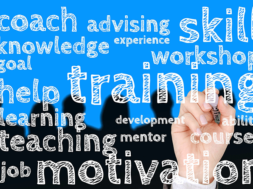

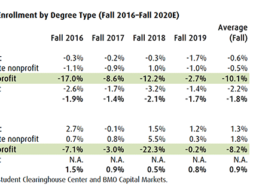



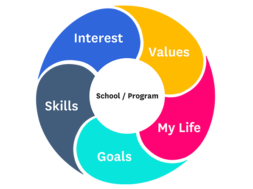

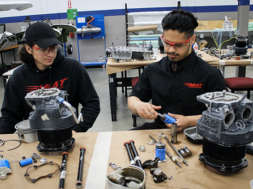




Comment(1)